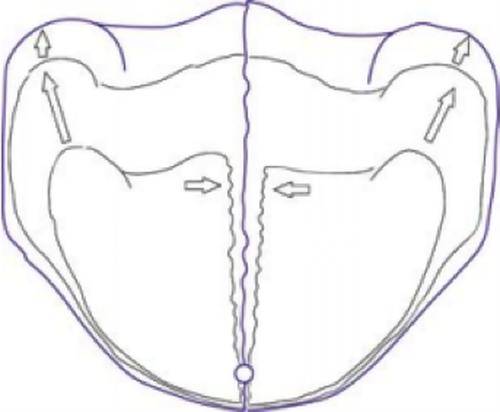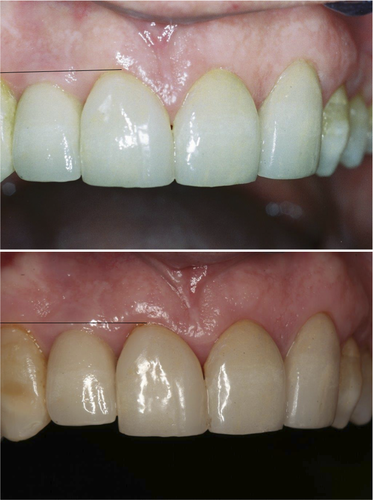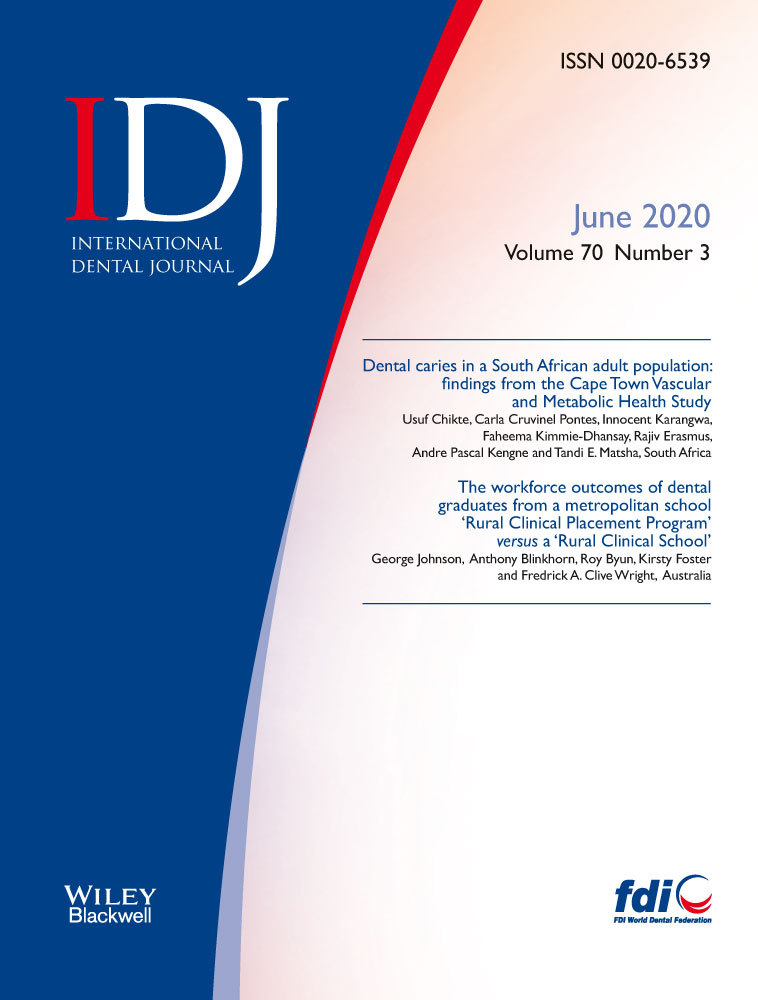Continuous tooth eruption adjacent to single-implant restorations in the anterior maxilla: aetiology, mechanism and outcomes – A review of the literature
Abstract
Introduction
Dental trauma and congenital anodontia are common causes of anodontia in the anterior maxilla. The proposed restorative treatment constitutes a challenge for many dentists, particularly if it is a question of a young patient who has not yet completed skeletal and dental development. Current treatments for anterior maxillary anodontia include: fixed or removable partial dentures; orthodontic closure of interdental spaces; and dental implants. Dental implants do not move with the dento-alveolar complex during the growth period of the maxilla. Therefore, many researchers maintain that implants should be postponed until after adolescence, in order to prevent complications, such as infra-occlusion, that would require the replacement of the abutment and crown-implant restoration, or even invasive treatments, such as the removal of the implant in the future. The objective of this literature review is to investigate the aetiology of the phenomenon, and outcome.
Results
Continuous tooth eruption is not affected by age, so considerable changes may occur due to eruption of adjacent teeth. In addition, both women and men are affected by this phenomenon and, usually, there is no significant difference in the amount of growth between the short face and the long face.
Conclusion
It can be concluded that continuous facial skeletal growth and teeth eruption are evident in the second and third decades. Where possible, it is advisable to delay placement of an anterior maxillary implant in the adolescent patient.
Introduction
Anodontia constitutes a functional and aesthetic problem, particularly in the anterior maxilla. Common causes for anterior maxillary anodontia are a congenital developmental deficiency, or trauma, both in adults and in young patients1. Anodontia is a challenging and complex clinical situation, particularly in young adolescent patients. Such treatments would include orthodontics, such as the closure of an interdental space along with restorative dental treatment, such as a facet or a crown, or conservative treatment, such as a Maryland bridge or a removable denture1.
Because these treatments may cause complications, such as poor long-term retention, periodontal disease and resorption of the alveolar ridge, many patients prefer implants1. Despite the recommendations of postponing implants until after adolescence, parents urge the dentist to supply a solution to shorten the waiting period2. Similarly, occasionally surgical interventions such as placing a dental implant may cause complications to adult and young patients in relation to continuous maxillary growth and adjacent teeth eruption2. Implants that have undergone osseointegration are similar to ankylotic teeth, and do not erupt or displace the adjacent teeth during the maxillary growth3, 4.
Studies published during the late 1980s show that dental implants that were inserted in the jaws of apes and dogs remained immobile during all of the experiments5. At the beginning of the 1990s, Odman et al. placed dental implants in pigs. The clinical and radiological findings from both studies showed that dental implants in young jaws behave as ankylotic teeth, and therefore do not erupt together with the adjacent developing dentition. According to these findings, the researchers advised to postpone placement of implants in young jaws5, 6.
Biological changes in the maxillary bones relate to three planes: sagittal, transversal and vertical3. In both of the jaws, the growth ends first in the transversal plane, subsequently in the sagittal plane, and ultimately in the vertical plane3.
Transversal growth
The lateral development of the anterior segment of the arch ends before adolescence, unlike the posterior segment whose width depends on the lengthening of the jaw and the continuous eruption of the rest of the teeth3. Placement of a central incisor implant in adolescent patients before the end of the transversal growth may cause the formation of a diastema between the crown and the adjacent central incisor and the deviation of the midline towards the implant, while an insertion of two central incisor implants may cause the creation of a diastema at 7 years of age3.
Sagittal growth
The maxillary arch lengthens due to a sutural growth and the addition of bone in the tuberosity region. The anterior segment is almost stable, but when the maxilla follows the growth of the mandible, more than 25% of the sutural growth disappears. Clockwise growth of the maxilla-mandibular complex results in bone loss in the labial region of the incisor area, and may cause the formation of fenestrations in the labial area of an incisor implant due to labial location of the implant compared with the adjacent natural incisors3 (Figure 1) .

In addition, horizontal growth occurs due to sutural growth, remodelling and continuous eruption. Usually, this growth ends at the age of 17–18 years in girls, and slightly later in boys3. The buccal surface of the maxilla resorbs, while in contrast the palatal bone is layered; a combination of buccal absorption and palatal layering plays an important role in the location of the maxillary teeth and their inclination. An implant located in the anterior maxilla prior to the end of growth will result in a labial location of the implant in relation to the adjacent teeth1.
Vertical growth of the face, skeletal and dental changes also occur after the second decade of life7-12. In addition, the main facial growth occurs in the inferior part of the face for both jaws7, 10, 11. A posterior rotation of the mandible causes vertical growth of the lower part of the face, accompanied by continuous tooth eruption in relation to the occlusal plane8. In addition, the anterior mandibular teeth usually protrude together with the rotation of the mandible11, and the anterior maxillary teeth follow this process in order to maintain a normal occlusion with the anterior mandibular teeth7, 8. Changes at the ages of 26–46 years in the sagittal and vertical planes continue in both men and women, while the crowding of the teeth in both jaws increases9. Recent studies show continuous tooth eruption adjacent to the dental implant in adult patients as well13-17. The outcome of the continuous multi-dimensional bone growth and tooth eruption in relation to the fixed position of the dental implant is expressed as poor dental aesthetics due to the submerged position of the implant and the crown in relation to the adjacent natural teeth14, 16, 18. Correcting this outcome is very challenging and may involve several regenerative surgical procedures. The process might be long, agonising and expensive, and therefore should be prevented if possible. The objectives of this study are to review the literature on the subject of continuous natural tooth eruption adjacent to a restoration over a single implant in the anterior maxilla in adolescent and adult patients, to investigate the aetiology of the phenomenon, its aesthetic effects, and outcomes.
Methods
Research has been published in the dental literature (which was identified using the main search engines Pubmed, Embase, Scopus) on the subject of continuous natural tooth eruption adjacent to a restoration over a single tooth implant in the anterior maxilla, using the keywords: ‘adjacent tooth to dental implants, continuous eruption, jaws growing, jaws development, anterior single implant, aesthetic implant’. The search was limited exclusively to articles in English published in dental peer-reviewed journals between 1980 and 2019. When at least one author considered that a publication met inclusion criteria, full text was obtained and evaluated for its eligibility. Disagreements about inclusion or exclusion were resolved by discussion. Afterwards, an additional manual search of the bibliographies of all selected full-text articles and relevant textbooks was performed by the authors.
Results
Twenty-seven articles met the search parameters. The data regarding the following parameters were collected: the effect of age on continuous teeth eruption (Table 1); the effect of gender on continuous teeth eruption (Table 2); the effect of the facial shape − long versus short facial shape (Table 3); the effect of absence of initial occlusal contact on continuous tooth eruption (Table 4); and the effect of the location of the implant within the anterior maxilla on continuous tooth eruption − central incisor, lateral incisor or canine (Table 5).
| Study publisher | Subjects | Follow-up | Conclusions |
|---|---|---|---|
| Andersson et al.13 |
34 patients 14 females, 20 males Mean age 31.9 years (15–57 years old) |
17–19 years | The risk for a submerged implant position is not completely age dependent and could be observed also in higher age groups |
| Bernard et al.14 |
14 mature adults (40–55 years old). 14 youngsters (15.5–21 years old) |
Follow-up of 1 year or more (mean interval 4.2 years) | Mature adults can exhibit changes in normal teeth position adjacent to implant-retained crowns to the same extent as adolescents or young adult individuals with residual growth potential |
| Huanca et al.15 |
24 females Mean age 48 years old |
10 years | Continuous teeth eruption was shown in female adult subjects, especially in the upper incisors area |
| Thilander et al. 26 | 10 adolescents: 14–19 years old | 8 years | Continuous teeth eruption was shown in 3 adult patients who had received a single implant as adolescent |
| Jemt et al.17 | One 25-year-old female | After 16 years in function | The clinical photographs and examination findings showed obvious signs of implant infraposition after 9 years |
| Schwartz-Arad et al. 20 |
35 patients 21 females, 14 males Mean age 29.3 |
At least 3 years | Implant submersion continues throughout adult life, its rate varies with age. It is evident that this phenomenon is much more conspicuous during the second and third decades of life as compared with the fourth and fifth |
| Study publisher | Age groups | Male versus female |
|---|---|---|
| Bernard et al.14 |
‘Young adults’ 15.5–21 years ‘Mature adults’ 40–55 years |
No difference was found between male and female patients |
| Schwartz-Arad et al.20 |
> 30 ≤ 30 |
Higher submersion rate in females (yet the results were not statistically significant) |
| Vilhjálmsson et al.22 | Mean age 34.8 years | No statistically significant differences were found between gender and eruption of teeth adjacent to implants in this study |
| Andersson et al.13 | Mean age at implant placement was 31.9 years | 40% of the patients showed signs of submersion both in younger and older age groups, but more frequently observed in female patients when the study ended |
| Jemt et al.19 | Mean age was 25.4 years | A possible relationship between significantly higher incidence of tooth movements adjacent to implants in females in the study group |
| Study publisher | Conclusions |
|---|---|
| Aarts et al. 23 | No difference between facial types in the timing of cessation of facial growth |
| Andersson et al.13 | No clear relationship between age at implant placement or facial shape to implant submersion was established |
| Jemt et al. 24 | Significantly greater increase of anterior facial height and posterior rotation of the mandible in the female reference group was observed. A possible relationship between significantly higher incidence of tooth movements adjacent to implants in females in the study group |
| Study publisher | Subjects | Conclusions |
|---|---|---|
| Huanca et al.15 | 24 females average age at T0 48 years | No statistical difference in the eruption pattern of central incisors with and without occlusal contacts with their antagonist statistical difference was evident in the eruption pattern of lateral incisors without occlusal contacts with their antagonist |
| Study publisher | Conclusions |
|---|---|
| Bernard et al.14 | Implant position in the anterior maxillary arch did not affect the amount of vertical growth or eruption of the adjacent teeth |
Discussion
A single implant in the anterior maxilla is a common treatment for the replacement of a missing tooth due to trauma or congenital anodontia. However, implants are anchored to the bone similar to an ankylotic tooth that does not change its place along with the skeletal growth and tooth eruption patterns. Until recently, it was common to believe that the continuous development of the jaws and teeth eruption are more significant in adolescent than in adult patients, especially when considering placing a dental implant in the anterior maxilla.13, 14
Forsberg et al.7 showed that continuous teeth eruption is present until the fourth decade of life. Schwartz-Arad et al.20 have found that the phenomenon of the submersion of a crown retained to an implant adjacent to a natural tooth in the anterior maxilla is more prominent in the second and third decades of life than in the fourth and fifth decades. Likewise, Fudalej et al.21 have shown a continuous development of the jaws and tooth eruption after adulthood, but to a lesser degree after the second decade of life.
New studies show continuous tooth eruption adjacent to a dental implant even in the fifth decade of life15. The effect of gender on continuous teeth eruption and jaw growth is debated; three out of five articles reported a more significant growth in females than in males.13, 20, 21 The other two articles showed no significant difference between genders.14, 22 Three articles studied the effect of a different facial type, the long face, and the short face, on the continuous vertical growth and teeth eruption. Two did not find any connection.13, 23 On the other hand, Jemt et al.24 showed that the anterior facial height together with a clockwise rotation of the mandible in females was increased significantly in comparison to males, and accordingly changes in tooth position in the anterior region of both jaws.
Huanca et al.15 investigated the effect of the presence or absence of initial occlusal contact on continuous tooth eruption in the anterior maxilla in adults, and found that maxillary central incisors erupt to the same extent with or without initial occlusal contact, whether the lateral maxillary incisors erupt to a greater extent when initial occlusal contact with the antagonist teeth is absent. Bernard et al.14 investigated the effect of the location of the implant within the anterior maxilla on the continuous vertical eruption of the adjacent teeth, and found no difference between the position of the central and lateral incisor and the position of the canine.
When considering all these findings it is reasonable to understand that continuous teeth eruption adjacent to the dental implant is unpredictable at the planning stage. The outcome however is predictable; the natural teeth adjacent to the implant continue to erupt in contrast to the anchored implant, resulting in submersion of the implant-retained crown, uneven crown length, uneven gingival line and poor aesthetics, as shown in Figure 2.

Restoring the anterior teeth is considered to be one of the greatest challenges in aesthetic dentistry. The efforts to correct this outcome are very challenging and may involve regenerative surgical procedures, gingival cosmetic surgery, orthodontic treatment and restorative dentistry. The process might be long, very unpleasant to the patient and expensive.25 A missing anterior tooth is not rare in the life span of both young and adult patients as a consequence of developmental reasons, dental trauma, or even failed dental treatment that necessitated tooth extraction. It is very common that patients suffering from a missing anterior tooth will ask the dentist for a suitable functional and aesthetic solution. When it comes to adult patients the most common solution would be to place an implant-retained crown. The dilemma begins when the adolescent patient and parents are urging the dentist for the same solution. These patients are suitable candidates for long-term transitional restorations, such as a Maryland bridge or any other non-removable temporary restoration.
Conclusion
It can be concluded from the data that continuous facial skeletal growth and teeth eruption is very evident in the second and third decades, but can last even to the fourth and fifth decades of life. Therefore, the submersion of anterior maxillary implants placed during these decades adjacent to natural teeth should not be a surprise. Accordingly, it is very reasonable to delay placement of an anterior maxillary implant in the adolescent patient, also inform the adult patient about the phenomenon, and receive a written informed consent before considering placing an anterior maxillary implant. For the adolescent patient, a long-term transitional restoration should first be considered.
Conflict of interest
The authors declare that there is no actual or potential conflict of interest, including any financial funding, personal or other relationships with other people or organisations that could inappropriately bias this work.




